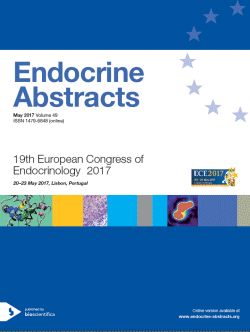
19th European Congress of Endocrinology
Lisbon,
Portugal
20 May 2017 - 23 May 2017
Eposter Presentations: Adrenal and Neuroendocrine Tumours
Adrenal medulla
ea0049ep87 | Adrenal medulla | ECE2017
Coexisting Graves’s disease and pheochromocytoma
Belaid Rim , Oueslati Ibtissem , Mimita Wafa , Khiari Karima , Abdallah Nejib Ben
ea0049ep88 | Adrenal medulla | ECE2017
Pheochromocytoma in neurofibromatosis type 1
Marengo Agustina Pia , Garcia-Sancho Paula , Guerrero Fernando , Peiro Inmaculada , Santacruz Elisa , Ortiz Andres , Diez Juan Jose , Iglesias Pedro , Villabona Carles
ea0049ep89 | Adrenal medulla | ECE2017
Should all patients with Neurofibromatosis type 1 undergo biochemical screening for Pheocromocytoma?
Al-Sharefi Ahmed , Ashraff Suhel , Vanka Ramesh , Nag Satyajit
ea0049ep90 | Adrenal medulla | ECE2017
Pheochromocytoma in pregnancy
Efe Belgin , Yorulmaz Goknur , Alaguney Sevil , Canaz Funda , Badak Bartu
ea0049ep91 | Adrenal medulla | ECE2017
The role of p27 in pheochromocytoma development
Kugler Andrea , Lalli Enzo , Almaraz Juan Higareda , Sass Steffen , Pellegata Natalia
ea0049ep92 | Adrenal medulla | ECE2017
Role of microenvironment on metabolic control of murine pheochromocytoma SDHB silenced cells
D'Antongiovanni Vanessa , Richter Susan , Martinelli Serena , Canu Letizia , Ercolino Tonino , Eisenhofer Graeme , Pacak Karel , Rapizzi Elena , Mannelli Massimo
ea0049ep93 | Adrenal medulla | ECE2017
Role of microenvironment on proliferation and migration of an SDHB silenced murine Pheochromocytoma cell line
Martinelli Serena , D'Antongiovanni Vanessa , Richter Susan , Canu Letizia , Ercolino Tonino , Eisenhofer Graeme , Pacak Karel , Rapizzi Elena , Mannelli Massimo
ea0049ep94 | Adrenal medulla | ECE2017
Pheochromocytoma: a clinical and pathological study
Santacruz Elisa , Marengo Agustina Pia , Ortiz Andres , Peiro Inma , Pian Hector , Diez Juan Jose , Garcia-Sancho Paula , Villabona Carles , Iglesias Pedro
ea0049ep95 | Adrenal medulla | ECE2017
Biochemical testing for pheochromocytoma
Faria Carolina , Barbosa David , Osorio Ana Sofia , Nobre Ema , Sampaio Joaquim , Bugalho Maria Joao
ea0049ep96 | Adrenal medulla | ECE2017
Paraganglioma and Fallot Tetralogy: case report
Martins Ana Filipa , Martins Joao Martin , do Vale Sonia
ea0049ep97 | Adrenal medulla | ECE2017
Retrospective audit at a UK teaching hospital of phaeochromocytomas and paragangliomas against the 2016 guidelines
ea0049ep98 | Adrenal medulla | ECE2017
Pheochromocytoma – surgical outcomes
Martins Pedro Carvalho , Ribeiro Catia , Peyroteo Mariana , Pereira Helena , de Sousa Abreu
ea0049ep99 | Adrenal medulla | ECE2017
Role of urinary fractionated metanephrines and catecholaminas in the diagnosis of pheochromocytoma/paraganglioma
Martinez-Triguero Ma Luisa , del Olmo Ma Isabel , del Olmo Rosa Camara , Alba Amparo , Fernandez Francis , Merino Juan Francisco , Laiz Begona
ea0049ep100 | Adrenal medulla | ECE2017
Lung adenocarcinoma in a 34-year-old female SDHB asynptomatic mutation carrier – case report
Matos Maria Joao , Costa Claudia , Santos Ana Paula , Teixeira Manuel , Franco Carlos , Bento Joao , Azevedo Isabel , Dias Susana , Sampaio Ines Lucena , Cunha Ana Luisa , Torres Isabel
ea0049ep101 | Adrenal medulla | ECE2017
Pheochromositoma in childhood
Evliyaoglu Olcay , Ercan Oya , Cakır Aydilek , Hopurcuoğlu Duhan , Cınar Betul
ea0049ep102 | Adrenal medulla | ECE2017
A case of silent pheochromocytoma presenting with clinical and radiological findings suggesting metastatic adrenal lesion
Cander Soner , Gul Ozen Oz , Sisman Pinar , Ersoy Canan
ea0049ep103 | Adrenal medulla | ECE2017
The storm before the calm: a phaeochromocytoma
Nikookam Yasmin , Bonner Caoimhe , Bettany Edward , Pittathankal Anthony , Gunasekara Ranjan , Casey Edel , Nikookam Khash
ea0049ep104 | Adrenal medulla | ECE2017
Improvement of insulin secretion and oral glucose tolerance after pheochromocytoma removal: a case report
Erlic Zoran , Roost Kathrin , Tschopp Oliver , Schmid Christoph
ea0049ep105 | Adrenal medulla | ECE2017
Ephedrine/caffeine toxicity masquerading as phaeochromocytoma in a vigorexic male with paroxysmal hypertension and headache
Nivelo-Rivadeneira Manuel , Kuzior Agnieszka , Quintana-Arroyo Sara , Acosta-Calero Carmen , Arnas-Leon Claudia , Santana-Suarez Ana Delia , Tocino-Hernandez Alba Lucia , Martinez-Martin Francisco Javier
ea0049ep106 | Adrenal medulla | ECE2017
Loss diagnosis of pheochromocytoma in the initial evaluation
Azevedo Teresa , Alves Marcia , Guimaraes Joana , Dantas Rosa , Balsa Ana Margarida , Inacio Isabel
ea0049ep107 | Adrenal medulla | ECE2017
Unexplained resistant hypertension in a young male with recurrent transient ischemic attacks, resembling endocrine hypertension
Suarez Ana Delia Santana , Nivelo-Rivadeneira Manuel , Kuzior Agnieszka , Arroyo Sara Quintana , Calero Carmen Acosta , Leon Claudia Arnas , Herrera Esperanza Perdomo , Martin Francisco Javier Martinez



